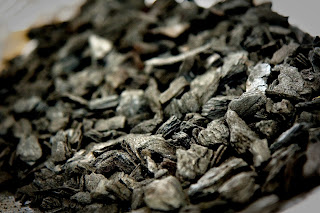Fixing carbon
As with all great stories it began with a potato. Longer than I care to admit, there was a time when I was a young and foolish teenager. Left at home on one of the rare occasions my parents went out, I got it into my thick skull to microwave a potato. Having no idea what to do, the timer was set to a shockingly high 40 minutes. The inevitable result was a dead microwave and a glowing black lump where the potato had once been. It was one of those painful experiences in life that one tries to forget but years later it opened up a line of thought. We need to get the amount of greenhouse gases in the atmosphere down, and fast. Could microwaving plant material help? Using patented technology, I’ve been working with a team to set up a new company called Carbonscape which is doing just that.
 |
| Refining carbon the natural way |
As many readers will know, technology now exists to capture carbon dioxide (CO2) direct from any major source that emits the offending gas. The crucial point is that the carbon dioxide can be captured and stored underground; an approach commonly referred to Carbon Capture and Storage (or CCS). This does sound rather wonderful but unfortunately there are still major problems. There are very real concerns that CCS may not be the environmental solution it’s cracked up to be: this technology only deals with greenhouse gas emissions produced by large single sources, such as power stations, while the captured gases that are supposedly stored have the potential of escaping back to the atmosphere. If this wasn’t enough, CCS won’t become commercially available for at least another decade and can only capture carbon dioxide being released in the future; it does nothing to claw back the CO2 that is already in the atmosphere.
Using photosynthesis, plants are remarkably efficient absorbers of carbon dioxide. One alternative approach is to utilise natural sinks for sequestering carbon. Forests are one possibility. The potential of the terrestrial biosphere is enormous. Consider the figures. Each year we emit 8 billion tonnes of carbon. In contrast, 120 billion tonnes of carbon are sucked out of the atmosphere each year by photosynthesis on land. Unfortunately for us, all of this is pretty much returned to the atmosphere through respiration and decomposition of plant material.
Fortunately, however, we know from scientific studies that charcoal can store carbon for thousands of years. Ancient fires preserved in archaeological sites, including those found with ancient human remains, show carbon can be stable for thousands of years. This is because charcoal is highly resistant to microbial breakdown. Once formed, the charcoal effectively keeps the carbon out of the atmosphere and ocean for virtually indefinite periods.
We’ve taken this idea a step further at Carbonscape. Developing an industrial-scale unit, we’re converting wood waste and other biomass into charcoal. Our proprietary industrial microwave technology means that in spite of the energy used during production, the carbon captured draws down significantly more carbon dioxide from the atmosphere than it produces. Each industrial-scale unit converts 40-50% of wood debris into charcoal; one tonne of carbon dioxide can be fixed as charcoal per day. By converting carbon in organic material to charcoal, it can be then put into the ground where it does the most good.
At Carbonscape we hope we’re adding a new commercial reason for reforestation. Once wood has been turned into charcoal, the cleared area can be replanted, allowing us to repeat the process when the plants have matured, effectively sucking yet more carbon dioxide out of the atmosphere. A great example is the USA: if the 200 million hectares of forest used for timber production were turned to charcoal instead, each crop rotation would help bring carbon dioxide levels down by some 10 parts per million. And it’s not just potatoes or wood that can be turned into charcoal: other organic material (even sewage) can be turned into a permanent carbon sink.
The possibilities for fixing carbon are truly enormous.


Comments
Post a Comment